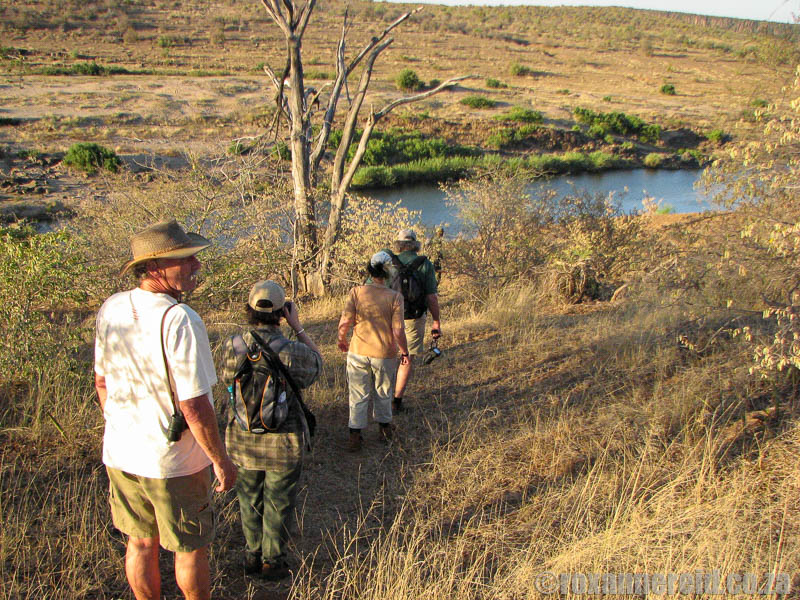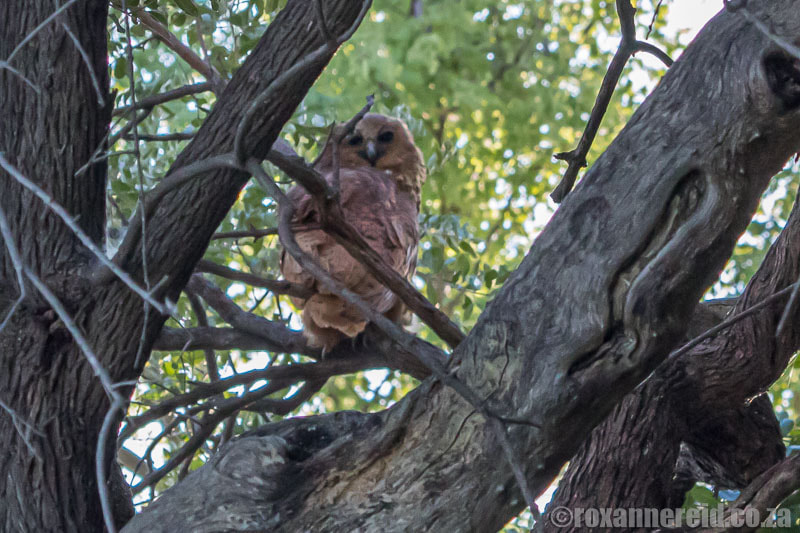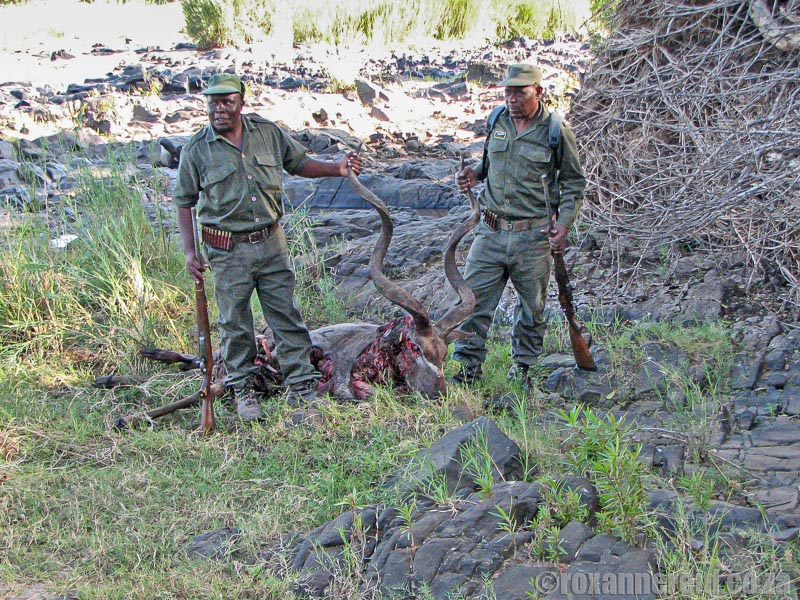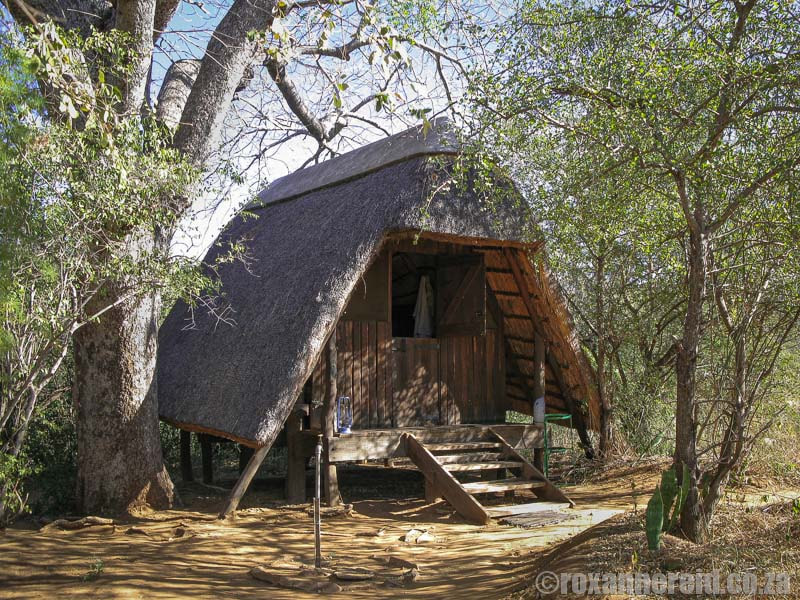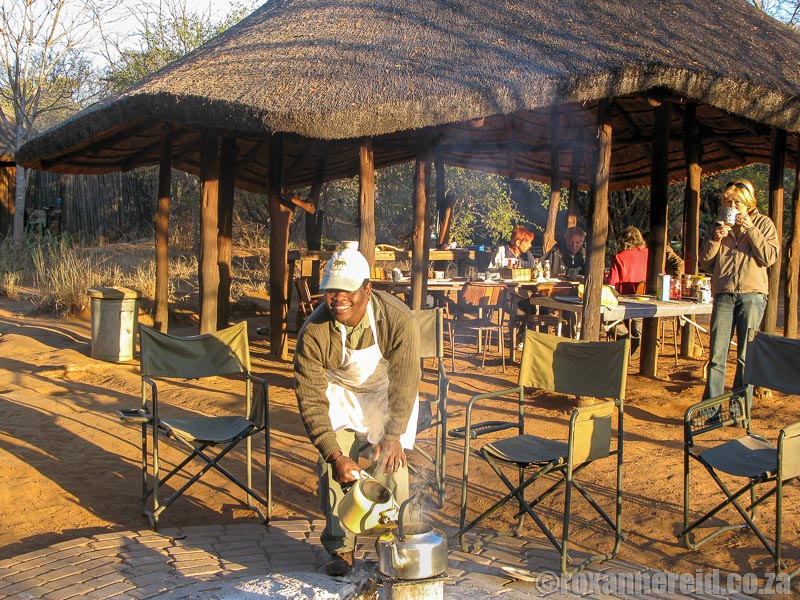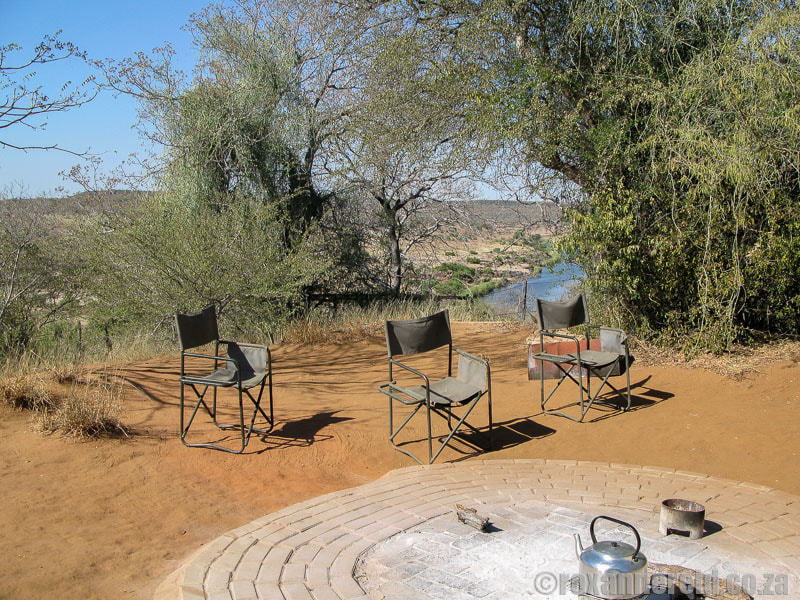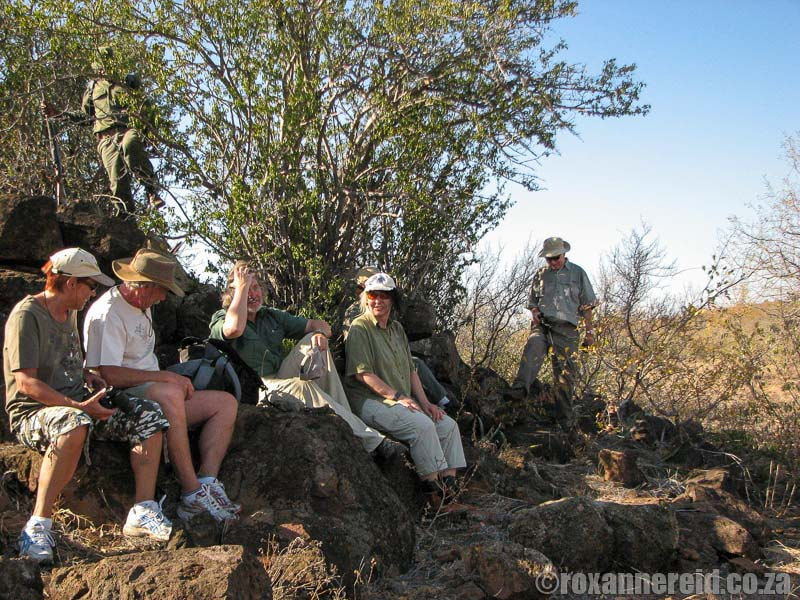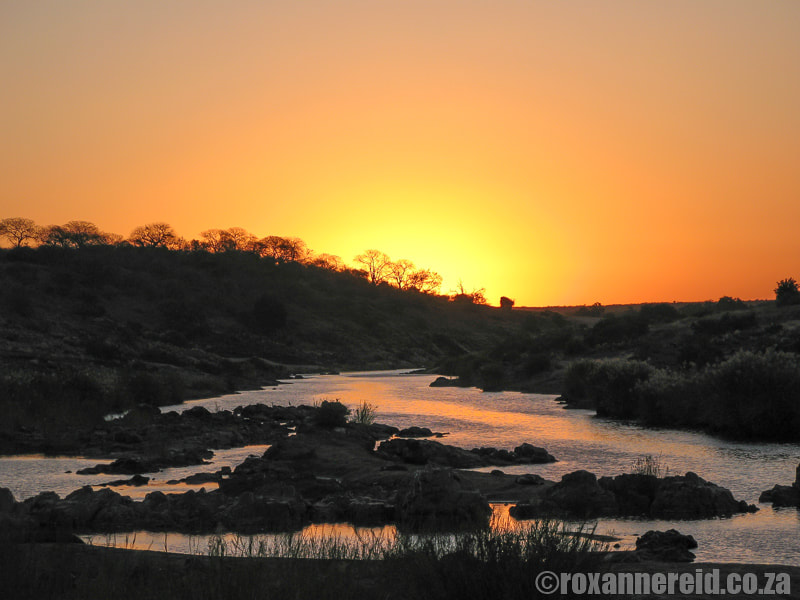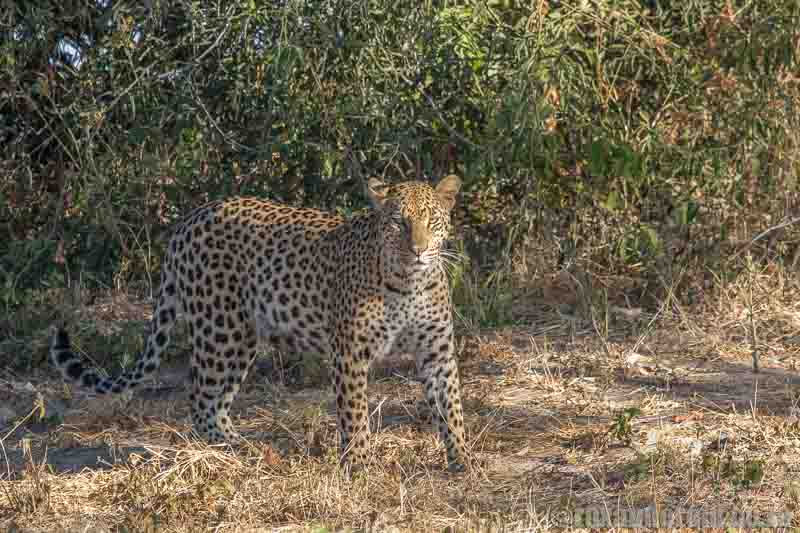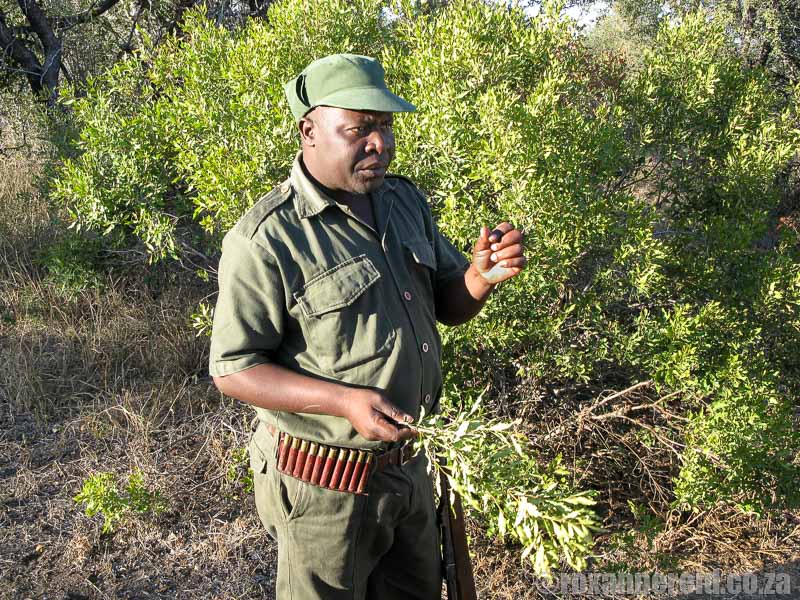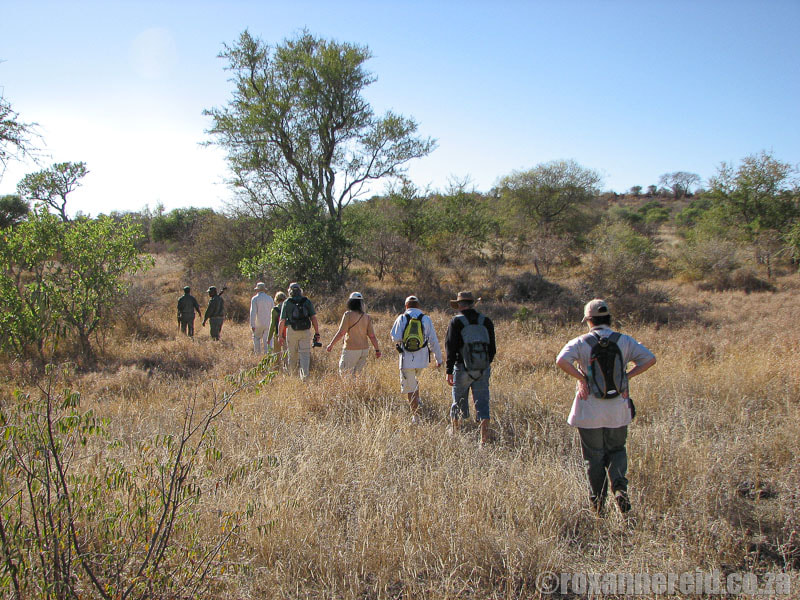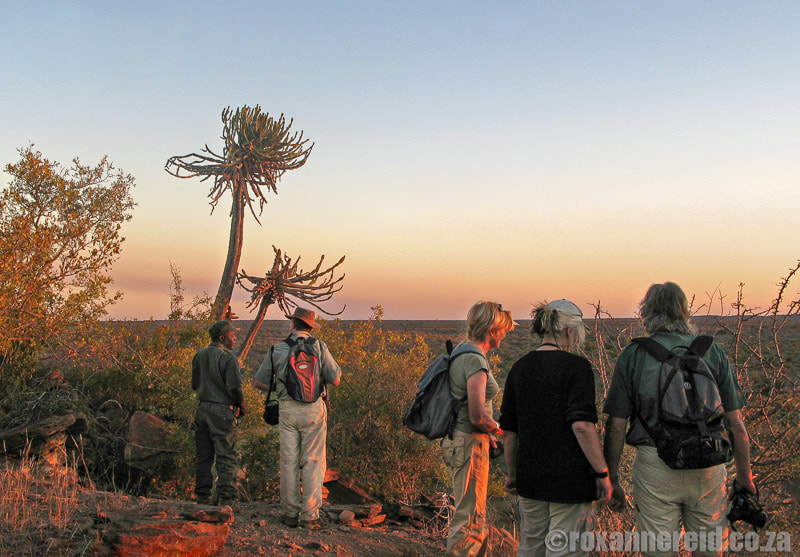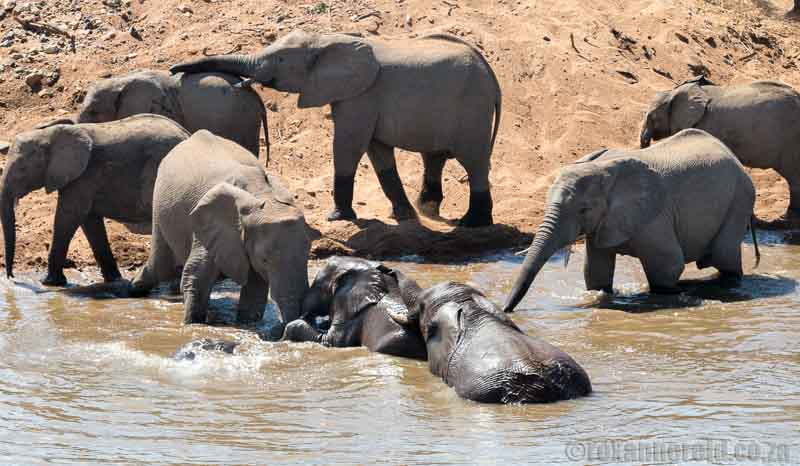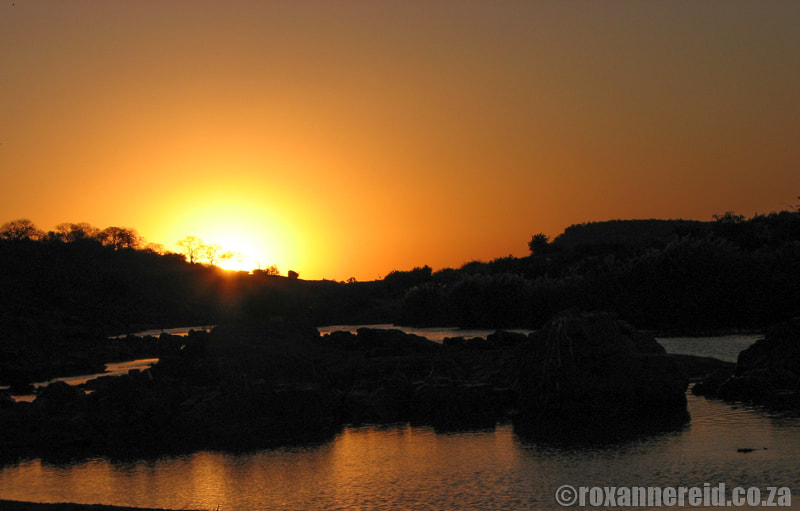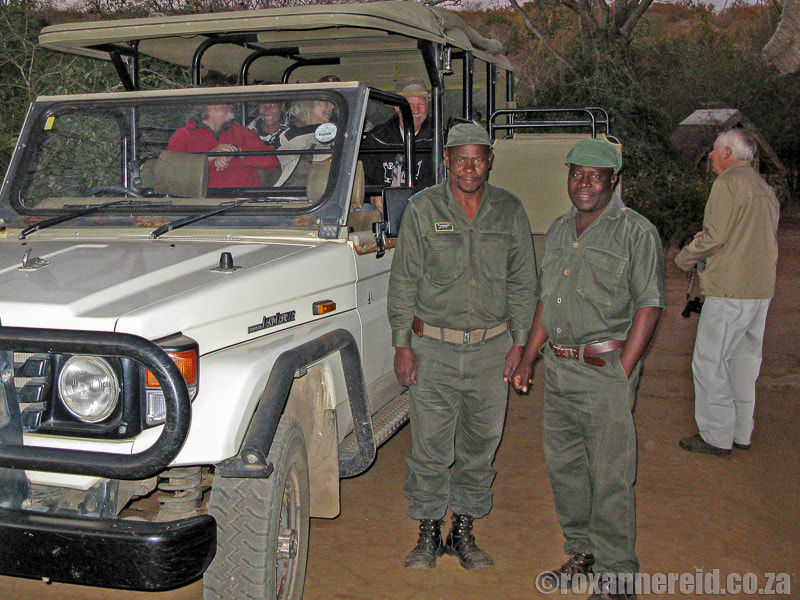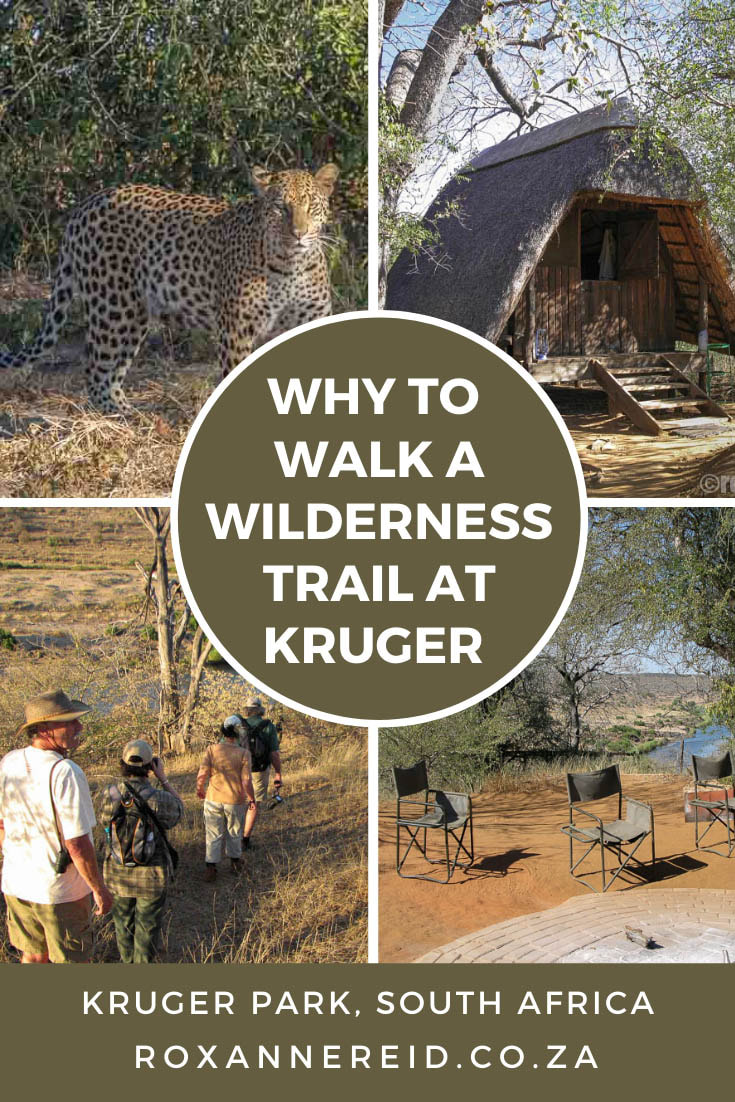
By Roxanne Reid
As anyone who has visited the Kruger National Park will know, it’s a place for a superb South African safari. We’ve visited countless times but perhaps our best experience was walking one of the wilderness trails. Find out why the Olifants Wilderness Trail at Kruger Park is so rewarding.
As anyone who has visited the Kruger National Park will know, it’s a place for a superb South African safari. We’ve visited countless times but perhaps our best experience was walking one of the wilderness trails. Find out why the Olifants Wilderness Trail at Kruger Park is so rewarding.
Self-driving through the Kruger National Park in South Africa is an outstanding experience, as is going on a guided drive to learn from a guide. But my favourite activity in the park has always been the early morning guided walks, a chance to slow down to nature’s pace, to not only see big game, but to spot and appreciate the little critters too. You use all your senses – see the tracks animals have left in the sand, hear the birds calling an alarm, smell the rich scent of a bush as you brush past it, feel the texture of a plant leaf, taste one of the edible or medicinal plants your guide tells you about.
Because we love bush walks so much, it seemed natural to book for one of the SANParks wilderness trails at Kruger Park some years back. We’d get to spend three nights and two days doing pretty much nothing else but walking in the bush, soaking up the knowledge of our ranger and tracker, and filing away the sights, sounds and smells to enjoy again later.
It was a winning decision.
Experience the Olifants Wilderness Trail at Kruger
We were peering into a tree looking at a Pel’s fishing-owl, ten people crashing and crunching through the riverine undergrowth and making more noise than a herd of 50 elephants. Leaves rustled behind us and we turned to find three lionesses and a young male slinking away across the dry riverbed just 40m away. In single file, we edged around a bend to see what they were scuttling from, only to find we’d disturbed them on their kill. A huge kudu bull lay half dismembered, munched on and very very dead.
It was a winning decision.
Experience the Olifants Wilderness Trail at Kruger
We were peering into a tree looking at a Pel’s fishing-owl, ten people crashing and crunching through the riverine undergrowth and making more noise than a herd of 50 elephants. Leaves rustled behind us and we turned to find three lionesses and a young male slinking away across the dry riverbed just 40m away. In single file, we edged around a bend to see what they were scuttling from, only to find we’d disturbed them on their kill. A huge kudu bull lay half dismembered, munched on and very very dead.
Soon ranger Aron Mkansi and tracker Sjambok Dzambukeri were high-fiving each other, broad grins all over their faces as they pointed out various gory aspects of the kill. These are the joys of being on the Olifants Wilderness Trail in the Kruger National Park. That day we’d already brushed noses with a clan of spotted hyenas, the pretty special Pel’s and a bunch of lions by nine in the morning.
Not that things had started all that well the day before, when the other party of four from Germany arrived to start the trail two hours late. Tales of flat tyres, lost comrades and speeding fines within Kruger’s borders didn’t mollify us because now we were arriving at the trail camp, with its dodgy paraffin lamps and outdoor ablutions, after dark.
As I was fussing around trying to find my torch so I could go for a pee I overheard their shocked realisation that they were supposed to bring their own booze; all that’s provided at the trails camps is food, water, fruit juice, tea and coffee. I was secretly thrilled; it seemed only fair that they should suffer. It was karma, I told myself, revelling in this sweet revenge. And we were blowed if we were sharing ours. We’d only brought a bottle of wine per night for our party of four to share so there was none to spare.
As I was fussing around trying to find my torch so I could go for a pee I overheard their shocked realisation that they were supposed to bring their own booze; all that’s provided at the trails camps is food, water, fruit juice, tea and coffee. I was secretly thrilled; it seemed only fair that they should suffer. It was karma, I told myself, revelling in this sweet revenge. And we were blowed if we were sharing ours. We’d only brought a bottle of wine per night for our party of four to share so there was none to spare.
Around the fire Aron delivered a safety briefing. ‘Walk in single file, don’t make noise, do what I tell you when I tell you and whatever you do don’t run because there’s no animal you can outrun. So take your walking shoes tomorrow and leave your running shoes behind.’
Dinner was a fairly chilly affair. We hadn’t yet quite forgiven the Germans for being late and they were depressed by the lack of booze. They were two grey-haired gents, an orange-haired Martina Navratilova look-alike and a woman we immediately dubbed Zebra Woman. The left side of her shoulder-length hair was dyed pitch black, the right side bleached white. There were zebra-pattern transfers on her nails and black-and-white dangly hoops in her ears. But her ready laugh had something of the warthog about it, often ending in a snort.
Aron, who had been mulling over things during dinner, announced that after we went in search of the special Pel’s in the morning, we’d take a quick drive to Olifants Camp for the Germans to stock up on booze. There was a shout of approval, and since we now knew there would be more coming, we started to share. The mood lifted and the bonding began. Clever Aron. ‘It’s all about ubuntu,’ he told us. Sharing and having sympathy for others.
An uninvited guest
If I was happy about bad karma for the Germans, perhaps I was too hasty because karma works both ways. I was punished when we went to bed, first with a hut that was right in the smoke line of the huge fire, producing a throat that felt like raw, smoked bacon.
Dinner was a fairly chilly affair. We hadn’t yet quite forgiven the Germans for being late and they were depressed by the lack of booze. They were two grey-haired gents, an orange-haired Martina Navratilova look-alike and a woman we immediately dubbed Zebra Woman. The left side of her shoulder-length hair was dyed pitch black, the right side bleached white. There were zebra-pattern transfers on her nails and black-and-white dangly hoops in her ears. But her ready laugh had something of the warthog about it, often ending in a snort.
Aron, who had been mulling over things during dinner, announced that after we went in search of the special Pel’s in the morning, we’d take a quick drive to Olifants Camp for the Germans to stock up on booze. There was a shout of approval, and since we now knew there would be more coming, we started to share. The mood lifted and the bonding began. Clever Aron. ‘It’s all about ubuntu,’ he told us. Sharing and having sympathy for others.
An uninvited guest
If I was happy about bad karma for the Germans, perhaps I was too hasty because karma works both ways. I was punished when we went to bed, first with a hut that was right in the smoke line of the huge fire, producing a throat that felt like raw, smoked bacon.
Second, with bats that had us bouncing up and down like jack-in-the-boxes for half the night to let them out the door. First Keith, then me, six times in all before Keith declared a truce and said if they were going to keep coming in the cracks between the poles and planks used to build the wooden A-frame huts, he was buggered if he was getting up again.
I sulked and fumed quietly for a while, trying to tell myself that it would be fine. Bats have good echo-location and radar skills, they wouldn’t bump into me, would they? Then sometime after midnight one flew straight into the side of my head. I yelped with surprise, then pulled the sheet up over my face and lay there as if in a morgue, trying to forget the sweltering heat.
But once the sun came up through a narrow band of cloud in an otherwise cloudless sky, all was forgotten in the splendour of the new day. Our lookout – obscured by darkness the previous night – was over the Olifants River, where I’d heard hippo honking as I lay awake under my bat-proof sheet. A hyena whooped softly a few times off to the right as we wolfed down coffee and rusks and by 06:15 we were in the 4x4 ready to be driven to the starting point of our first walk.
This time the Germans weren’t late.
I sulked and fumed quietly for a while, trying to tell myself that it would be fine. Bats have good echo-location and radar skills, they wouldn’t bump into me, would they? Then sometime after midnight one flew straight into the side of my head. I yelped with surprise, then pulled the sheet up over my face and lay there as if in a morgue, trying to forget the sweltering heat.
But once the sun came up through a narrow band of cloud in an otherwise cloudless sky, all was forgotten in the splendour of the new day. Our lookout – obscured by darkness the previous night – was over the Olifants River, where I’d heard hippo honking as I lay awake under my bat-proof sheet. A hyena whooped softly a few times off to the right as we wolfed down coffee and rusks and by 06:15 we were in the 4x4 ready to be driven to the starting point of our first walk.
This time the Germans weren’t late.
First full day with the ranger and tracker
With around 45 years of experience between them, Aron and Sjambok communicated silently, by hand signals alone. Aron had an amusing way of getting his message across, mixing solid information with a dollop of humour to keep us involved.
We crossed a narrow hippo path leading down to the river. ‘You see this cement?’ he asked, pointing to blobs of white stuff on the ground. ‘At one time we were wanting to pave this path down to the river…’ Then he chuckled. ‘No, they’re hyena droppings and they’re white like that because of the high calcium content in the bones that they eat.’ This is painless learning, and the humour helps to cement (excuse the pun) the information in our brains.
The trail was great. We didn’t have to obsess about the Big Five – although as it turned out we did see three of them. We could get excited about tracks, about broken bits of grass and what they might be telling us, about trees and shrubs and their uses to man and animals; we could even get excited about poo (officially called scat) and the dung beetles who help to rid the veld of it.
With around 45 years of experience between them, Aron and Sjambok communicated silently, by hand signals alone. Aron had an amusing way of getting his message across, mixing solid information with a dollop of humour to keep us involved.
We crossed a narrow hippo path leading down to the river. ‘You see this cement?’ he asked, pointing to blobs of white stuff on the ground. ‘At one time we were wanting to pave this path down to the river…’ Then he chuckled. ‘No, they’re hyena droppings and they’re white like that because of the high calcium content in the bones that they eat.’ This is painless learning, and the humour helps to cement (excuse the pun) the information in our brains.
The trail was great. We didn’t have to obsess about the Big Five – although as it turned out we did see three of them. We could get excited about tracks, about broken bits of grass and what they might be telling us, about trees and shrubs and their uses to man and animals; we could even get excited about poo (officially called scat) and the dung beetles who help to rid the veld of it.
Take civet poo, for example. For a relatively small animal, it has a rather impressive diameter. We could easily identify the millipede skeletons in it, giving a hint of the civet’s diet. Apparently, although evolution gave millipedes the defence of being toxic, this doesn’t bother the tough little civet one bit.
Not long after the excitement of the lion kill, we stopped on a koppie of flattish rocks for breakfast. ‘This is the restaurant,’ said Aron, waving his arm. ‘You can sit inside in the shade, or you can sit on the verandah in the sun.’ He took a ‘tablecloth’ (which looked suspiciously like a black garbage bag) from one of the backpacks we’d carried up, set it on a large rock, added Provita, cheese, wors, dried fruit and Liquifruit and invited us to tuck in at his self-service restaurant. ‘Remember, the more you eat, the less you have to carry back.’
Not long after the excitement of the lion kill, we stopped on a koppie of flattish rocks for breakfast. ‘This is the restaurant,’ said Aron, waving his arm. ‘You can sit inside in the shade, or you can sit on the verandah in the sun.’ He took a ‘tablecloth’ (which looked suspiciously like a black garbage bag) from one of the backpacks we’d carried up, set it on a large rock, added Provita, cheese, wors, dried fruit and Liquifruit and invited us to tuck in at his self-service restaurant. ‘Remember, the more you eat, the less you have to carry back.’
After lunch and some downtime in camp during the heat of the day, late in the afternoon we set out on foot along the river below the camp for the second walk of the day. Grey-headed, great white and goliath herons were all around, a fish eagle was calling from a treetop and an osprey few overhead.
Hippos snorted at us and crocs bared their teeth, but we reached Sundowner Rock unscathed, cracked open beers or cold drinks and watched a dozen hippos swimming off the heat of the day. The hippos watched us too, pink blobs of eyes blinking just above the water, an ear or two twitching, as we lapped up the sunset over the river.
Hippos snorted at us and crocs bared their teeth, but we reached Sundowner Rock unscathed, cracked open beers or cold drinks and watched a dozen hippos swimming off the heat of the day. The hippos watched us too, pink blobs of eyes blinking just above the water, an ear or two twitching, as we lapped up the sunset over the river.
A leopard kill, lots of tracks and scat
We’d obviously passed some sort of test because on our second day Aron decided to increase our pace and expand our range. Then Sjambok found a story in the sand. A short dialogue in Shangaan between the two rangers followed, with much pointing and arm action. A leopard had killed an impala here and dragged it off stage left. We were to engage super-silent mode and follow with our eyes peeled. With luck we’d find the leopard or at least where it had slung the carcass in a tree.
We’d obviously passed some sort of test because on our second day Aron decided to increase our pace and expand our range. Then Sjambok found a story in the sand. A short dialogue in Shangaan between the two rangers followed, with much pointing and arm action. A leopard had killed an impala here and dragged it off stage left. We were to engage super-silent mode and follow with our eyes peeled. With luck we’d find the leopard or at least where it had slung the carcass in a tree.
After 20m I was convinced they’d lost the spoor, yet we continued to bundu bash through thicket and donga. Then, about 50m from where the impala had been killed, Sjambok spotted the leopard melting into the dappled shade and there was the impala half hidden in a bush, one leg already in the leopard’s tummy for breakfast.
Once we’d had our lesson on the killing method of the leopard and how it’s not a greedy feeder, we moved on so the leopard could come back to reclaim its kill before the hyenas or vultures got wind of it and stole it away.
We were on a spoor roll now and soon we were learning to tell white rhino from black. The side toes in the white rhino are bigger, for one thing. Aron also explained the differences between the animals themselves. The white rhino has a flat lip because it eats only grass. In fact, it’s so well designed for mowing that it can barely lift its head above shoulder height. The black rhino has a hooked lip perfect for grasping the leaves it feeds on.
He gave us a simple picture to remember which is which when it comes to babies, which one goes ahead of mum and which one follows behind. ‘The white mother pushes the baby in front in a pram, but the black mother carries her baby on her back,’ he said.
Back on our favourite subject of poo, we learned to tell the difference between the two types of rhino and an elephant. White rhino poo is all grass, whereas black rhino poo will contain twigs carefully sawn off at a 45-degree angle. And of course ellie poo will contain a bit of everything – grass, leaves, even bark.
And how fresh is it? Aron stuck his finger into the poo and put it in his mouth. We were wise to how you stick your middle finger in but put your forefinger in your mouth – an old ranger’s trick – but the Germans looked satisfyingly horrified.
Once we’d had our lesson on the killing method of the leopard and how it’s not a greedy feeder, we moved on so the leopard could come back to reclaim its kill before the hyenas or vultures got wind of it and stole it away.
We were on a spoor roll now and soon we were learning to tell white rhino from black. The side toes in the white rhino are bigger, for one thing. Aron also explained the differences between the animals themselves. The white rhino has a flat lip because it eats only grass. In fact, it’s so well designed for mowing that it can barely lift its head above shoulder height. The black rhino has a hooked lip perfect for grasping the leaves it feeds on.
He gave us a simple picture to remember which is which when it comes to babies, which one goes ahead of mum and which one follows behind. ‘The white mother pushes the baby in front in a pram, but the black mother carries her baby on her back,’ he said.
Back on our favourite subject of poo, we learned to tell the difference between the two types of rhino and an elephant. White rhino poo is all grass, whereas black rhino poo will contain twigs carefully sawn off at a 45-degree angle. And of course ellie poo will contain a bit of everything – grass, leaves, even bark.
And how fresh is it? Aron stuck his finger into the poo and put it in his mouth. We were wise to how you stick your middle finger in but put your forefinger in your mouth – an old ranger’s trick – but the Germans looked satisfyingly horrified.
In case you get the idea that these walks were all about poo, let’s say Aron was something of a walking encyclopaedia on plants as well. Take the ‘magic’ gwarrie bush, for instance. Whatever your need is, it would seem to be covered by this wonder bush. Laxative, fly swat, rash ointment, comfy mattress, water freshener, fly repellent, even toothbrush. ‘Select a twig and remove the bark from about one centimetre at one end,’ said Aron, demonstrating. ‘Chew to the desired hardness, hard, medium or soft. Then use as a toothbrush mixed with ash from the leadwood tree.’
The shepherd’s tree was another opportunity for him to share his knowledge. Apart from providing really cool shade for animals on a hot day, it’s sacred to the Tswana, who will cut a branch to bring to a lekgotla to ensure that any disputes are settled peacefully.
The shepherd’s tree was another opportunity for him to share his knowledge. Apart from providing really cool shade for animals on a hot day, it’s sacred to the Tswana, who will cut a branch to bring to a lekgotla to ensure that any disputes are settled peacefully.
Elephants in the afternoon
In the afternoon we headed north along the river, clambering out of the vehicle at a collection of large reddish rocks already looking warm and inviting in the late afternoon sun. Sjambok heard something and Aron put up his hand for silence. We all froze for a long moment. Aron threw some grass seeds in the air and watched where the wind took them. They could hear elephants in the river below, so instead of going straight down the bank, they decided to make a wide detour to come downwind of them.
In the afternoon we headed north along the river, clambering out of the vehicle at a collection of large reddish rocks already looking warm and inviting in the late afternoon sun. Sjambok heard something and Aron put up his hand for silence. We all froze for a long moment. Aron threw some grass seeds in the air and watched where the wind took them. They could hear elephants in the river below, so instead of going straight down the bank, they decided to make a wide detour to come downwind of them.
As we descended into the riverbed, we faced yet another poo test. This time it looked much like white rhino poo, all grassy. It wasn’t only on the ground, but festooning a tree, collecting like Christmas decorations on the branches. And that means it was hippo poo.
‘Long ago, the hippo wanted to be allowed to swim in the river,’ Aron told us. ‘But God didn’t want such a big animal in the river if it was going to eat all the fish, so the hippo promised not to eat fish, just vegetation. And to prove to God it isn’t eating fish, it sprays its dung all over the place with its tail so He can check there are no fish bones.’
‘Long ago, the hippo wanted to be allowed to swim in the river,’ Aron told us. ‘But God didn’t want such a big animal in the river if it was going to eat all the fish, so the hippo promised not to eat fish, just vegetation. And to prove to God it isn’t eating fish, it sprays its dung all over the place with its tail so He can check there are no fish bones.’
By now we’d come downwind of where the elephants had been but they’d melted away without a sound, as only tiptoeing elephants can do. We tracked their course up and out of the river bed, finding dung just minutes old, and climbed onto a rock that gave a perfect view of the elephants, about 15 of them quietly feeding on the other side of the river.
After a suddenly freezing night in which we closed virtually all the shutters but the cold still came in through the slits and openings of the hut, our last morning began with Sjambok having a laughing fit before we were even properly awake. We just lay there and chuckled along with him without knowing why. That’s happiness at five in the morning.
Then the hyenas called goodbye, the lions roared and the fish eagle flew over with one last farewell.
Then the hyenas called goodbye, the lions roared and the fish eagle flew over with one last farewell.
What you need to know about Kruger's wilderness trails
Note: A version of this article first appeared in my book A Walk in the Park: travels in and around South Africa’s national parks
You may also enjoy
15 things to do in northern Kruger National Park
Satara: Big Five country in the Kruger Park
Like it? Pin this image!
- There are seven wilderness trails at Kruger: Bushmans and Wolhuter (the latter was the first trail to open in 1978), which leave from Berg-en-Dal camp; Napi from Pretoriuskop; Mathikithi and Sweni from Satara; Olifants from Letaba; and Nyalaland from Punda Maria (a good trail for birders).
- Each trail is two days and three nights, starting either on a Wednesday afternoon or a Sunday afternoon. Book in at reception of the camp the trail leaves from (see point 1) and be ready to meet your guide/ranger at 15:30 and to leave promptly afterwards. It’s a good idea to book accommodation in the park for the night before to make sure you’re not late. Allow time for this check-in and for signing an indemnity form.
- A maximum of eight people are allowed on each trail at any time.
- The age limit on the trails is between 12 years and 65 years.
- You don’t have to be super-fit, though being fit will increase your enjoyment. You need to be able to walk about 15-20km a day, though the pace is more about experiencing the wilderness than breaking any speed records.
- Don’t expect five-star luxury, but you’ll be blown away by the far-from the madding-crowd experience that’s very special.
- The trail camps are very rustic, without electricity or generators. You sleep in thatched A-frame huts – or in the case of Napi and Mathikithi, in tents – with communal flush toilets and gas showers. The exception is the Napi Trail where your tent has an en suite bathroom. Bed linen and towels are supplied at all the trail camps.
- Being on foot slows you down and makes you feel part of the environment. It’s a chance to see not only the Big 5 but smaller creatures, birds, plants and tracks.
- You usually go out in the early morning for a few hours with a packed breakfast, return to camp in the heat of the day, and go out again later in the afternoon.
- The camp chef prepares all your meals, which are tasty and filling. If you’re vegetarian or have other dietary requirements, you need to let them know beforehand and they will do their best to accommodate you. (You should understand, though, that ‘out-there’ complicated diets can’t be prepared separately for you).
- Drinking water, fruit juice, tea and coffee are included, but if you want alcohol or cold drinks you need to bring your own. There’s a small communal fridge to keep them in.
- Pack comfy clothes in neutral colours. Include a warm jacket for cold early starts. Make sure you have comfortable closed walking shoes, preferably with support for your ankles over uneven terrain.
- Other items to take along include camera, binos, sunglasses, hat, insect repellent and plenty of sun block. There won’t be cell phone signal but you might want to use your phone to take photos. A sturdy walking pole may be useful but a torch and headlamp are essential for getting around camp at night where there’s no electricity, just paraffin lamps or solar.
- Listen to what your ranger/guide tells you. He’s the one who will keep you safe.
- When is the best time for a wilderness trail at Kruger? Try to avoid the height of summer, when temperatures at Kruger can reach more than 40 degrees Celsius. Although you don’t walk in the middle of the day when the heat is at its worst, in my view it’s better to avoid the months of November to February. Of course, if high temperatures don’t worry you in the least, go for it - just remember to stay hydrated.
- Anti-malaria precautions are essential, especially in summer. Talk to your travel clinic or pharmacy about malaria prophylaxis and carry plenty of mosquito repellent to apply at dawn and dusk. I recommend wearing long sleeves and closed shoes with socks in the evenings because mosquitoes love unprotected flesh, especially your feet and ankles.
- Try to book 11 months ahead because these wilderness trails are very popular and the spots get snapped up quickly. Book online on SANParks’ website or by phoning Central Reservations, tel +27 (0)12 428-9111.
- Find out more about the wilderness trails on SANParks’ wilderness trails page.
Note: A version of this article first appeared in my book A Walk in the Park: travels in and around South Africa’s national parks
You may also enjoy
15 things to do in northern Kruger National Park
Satara: Big Five country in the Kruger Park
Like it? Pin this image!
Copyright © Roxanne Reid - No words or photographs on this site may be used without permission from roxannereid.co.za
